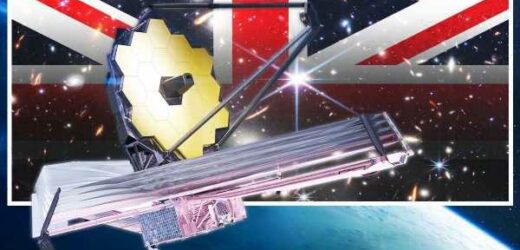Nasa prepares the James Webb Space Telescope for launch
We use your sign-up to provide content in ways you’ve consented to and to improve our understanding of you. This may include adverts from us and 3rd parties based on our understanding. You can unsubscribe at any time. More info
The spiritual successor to the Hubble Observatory, James Webb is the most powerful space telescope ever to have been launched and brings with it vastly improved resolution and sensitivity for infrared astronomy. This means that the telescope will be able to see objects that are too faint and distant — and, because of the time their light takes to reach us, old — for detection by Hubble. In fact, it is expected that the JWST will allow us to make observations of the universe’s first stars and the formation of the earliest ever galaxies.
It is also expected, however, that James Webb will turn its eye to studying exoplanets — that is, worlds orbiting other stars — and determine their atmospheric compositions.
The JWST mission is led by NASA, the European Space Agency (ESA) and the Canadian Space Agency.
Last night, US President Joe Biden unveiled the first publicly released image from the telescope which is also the oldest and highest resolution image of the universe to date.
The stunning shot shows SMACS 0723 — now known as “Webb’s First Deep Field” — a galactic cluster lying some 4.6 billion light-years away, within the constellation of Volans, a region of the sky which can be seen on Earth from the southern hemisphere.
The beauty of the image, however, is that the mass of the galaxy cluster acts as a so-called “gravitational lens” — distorting and amplifying the light coming from beyond it much like a magnifying glass.
In this way, JWST has been able to glimpse faint galaxies that are even more distant and older, dating back to a whopping 13.5 billion years ago — only 0.3 billion years after the universe first formed.
During a briefing at the White House, Mr Biden said: “It’s a new window into the history of our universe. Today, we’re [getting] a glimpse of the first light to shine through that window.”
NASA Administrator Bill Nelson added: “Webb’s First Deep Field is not only the first full-colour image from the James Webb Space Telescope, but it’s also the deepest and sharpest infrared image of the distant universe, so far.
“This image covers a patch of sky approximately the size of a grain of sand held at arm’s length. It’s just a tiny sliver of the vast universe.
“This mission was made possible by human ingenuity. Webb is just the start of what we can accomplish in the future when we work together for the benefit of humanity.”
A further batch of full-colour images captured by the space telescope is expected to be released by NASA and its partners at around 2:30pm today.
Launched from the Guiana Space Centre on Christmas Day last year, the $10billion (£7.64billion) telescope carries four main science instruments.
These include the Near InfraRed Camera (NIRCam), the Near InfraRed Spectrograph (NIRSpec) and the Fine Guidance Sensor and Near Infrared Imager and Slitless Spectrograph (FGS/NIRISS), a combined instrument used to both make observations and also to stabilise the image during observations.
The fourth piece of scientific hardware, “MIRI” — the “Mid-InfraRed Instrument” — contains a mid-infrared camera, an imaging spectrometer and a so-called coronagraph, which allows the light from bright stars to be blocked out to reveal the fainter objects around them.
It was designed to be able not only to see the faint light from the most distant stars, but also to peer through dust and gas to witness stars being born.
MIRI was designed, built and tested by the US in partnership with a consortium of 10 European countries — with the UK taking the lead.
The development of the instrument was funded by the UK Space Agency (UKSA), the Science and Technology Facilities Council (STFC) and the ESA.
Work on MIRI involved researchers from RAL Space, who developed the thermal hardware; the University of Leicester, who were responsible for the instrument’s mechanical design, and Airbus UK, who took the lead on the engineering front.
The European contribution to MIRI has been led by Professor Gillian Wright of the STFC’s UK Astronomy Technology Centre in Edinburgh.
Back in December, when the JWST was launched, Prof Wright said: “MIRI is a special instrument for the breadth of its science, the team that built it, and being the coolest instrument on Webb.
“The MIRI team rose to the challenges and brought some exquisite engineering solutions to make it a reality.
“The Webb mission as a whole is an amazing technological breakthrough in scale and complexity, and this extends to the instruments — including MIRI.”
DON’T MISS:
Heat pump owner furious with boiler alternative: ‘Winter was tough’ [INSIGHT]
Sturgeon’s independence dream crushed as UK unveils energy plan [ANALYSIS]
MoD sparks fears as ‘nuclear warheads’ driven down UK motorway [REPORT]
The UK Space Agency’s head of space science, Dr Caroline Harper, told Express.co.uk: “We’ve been at the core of the instrument development by leading on MIRI.
“And now we’re set to be at the forefront of the exciting scientific discoveries that are going to be made using MIRI and the other instruments on the James Webb Space Telescope over the next decade.
“The reason I say that is that project teams from around the world have applied to NASA through a competitive process for time to use the telescope in the first year of its observations.
“Of the successful proposals in that first year, more are led by UK scientists than any other non-US country — which is a huge achievement and speaks volumes about the quality of the science that is done in the UK.”
Dr Harper added that leading on one of James Webb’s instruments has really helped raise awareness and enthusiasm around what UK scientists can achieve using the telescope.
She continued: “The fact that we led on the hardware has got to have had a part to play in the fact that we’re not doing very well in getting to do science on the telescope.”
Astronomer Dr Emma Curtis-Lake, who is the STFC Webb Fellow at the University of Hertfordshire, told Express.co.uk: “There has been huge involvement in the MIRI instrument, with partners across the UK contributing to the design, build, testing and quality control.
“Further to this, a great many UK researchers have access to the telescope with the first year of operations, with scientists at the Universities of Hertfordshire, Cambridge, Oxford, Liverpool and Manchester contributing to the JWST Advanced Deep Extragalactic Survey (JADES) — which is aiming to reveal the early phases of galaxy formation.
“This project has access to over 800 hours of time with the JWST, part of which will be spent observing the famous Hubble Ultra Deep Field in October this year.”
Dr Curtis-Lake exclaimed that the first image revealed last night was “really beautiful”.
She added: “Webb has unveiled whole galaxies that Hubble couldn’t see, shown details and underlying structure that were not visible in the Hubble images, and given us an incredible preview of what’s to come.
“What Webb managed in 12 hours is really astounding compared to what Hubble managed in around 10 days. And there’s so much more to come!”
The faint and extremely distant galaxies in this region of the sky were revealed by Hubble through long-exposure observations.
Because of the time the light from these galaxies took to reach Earth, we are seeing a snapshot of them as they appeared just half-a-billion years after the Big Bang.
Dr Curtis-Lake continued: “There is also PRIMER [Public Release IMaging for Extragalactic Research], one of the largest surveys from which data will be immediately available to the whole scientific community, which is led by Professor Jim Dunlop at the University of Edinburgh.
“So, not only has the UK been instrumental in the delivery of an amazing instrument, MIRI, — we’re also ready to exploit this amazing telescope to provide new scientific discoveries.”
DON’T MISS:
Heat pump owner furious with boiler alternative: ‘Winter was tough’ [INSIGHT]
Sturgeon’s independence dream crushed as UK unveils energy plan [ANALYSIS]
MoD sparks fears as ‘nuclear warheads’ driven down UK motorway [REPORT]
The development and testing of the MIRI instrument, however, is far from the UK’s only involvement with the James Webb Space Telescope mission.
In fact, two senior UK physicists — Professors Andrew Bunker of the University of Oxford and Roberto Maiolino of the University of Cambridge — have been appointed to the NIRSpec Science team by the ESA and will have major roles in the early science coming from this instrument.
Furthermore, several UK companies and universities were awarded subcontracts for the development of critical components for JWST through NASA, the ESA and the MIRI team.
Dr Harper concluded: “We have a big community of scientists in the UK who are already starting work, gearing up to use the scientific data from James Webb.
“And as I say, there are more UK led science proposals to use time on the telescope in the first year than any other non-US country.
“So, it’s safe to say that our scientists will be working flat out on making some really exciting discoveries and keeping the UK at the forefront of space science discoveries in the future.”
Source: Read Full Article








